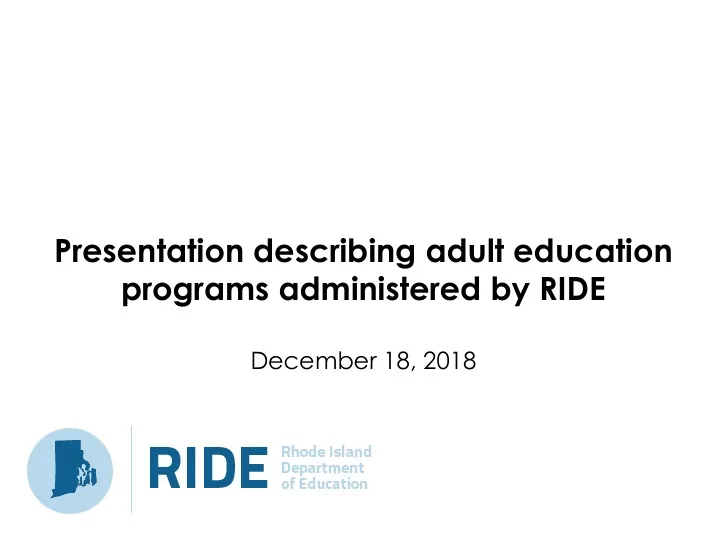

Presentation describing adult education programs administered by RIDE December 18, 2018
Adult Education at a Glance RIDE funded adult education programs awarded $6.9M in FY19. These investments create opportunities for nearly 5,700 adult learners. • The majority of programs are community-based organizations • Other program sponsors include colleges, school districts, libraries, and correctional facilities Adult Education Programs • Adult Basic Education (ABE) classes in reading, writing, and mathematics for adult performing between 1st and 8th grade levels • Adult Secondary Education (ASE) classes in reading, writing, and mathematics for adults performing between 9th and 12th grade levels • English as a Second Language (ESL) classes for English language learners Specialized Programs • High School Equivalency Diploma • Contextualized Instruction aligned to in high-demand occupations (e.g., health care and hospitality) 2
3 Profile of an Adult Student Grade Levels Demographics Age 6% 4% 7% 6% 11% 15% 13% 18% 33% 15% 61% 50% 61% Asian Black Hispanic 16-18 19-24 25-44 45-54 55+ ≤ 8th ≤ 8th & ESL 9th-12th White Other 94% of students perform at less than a 9 th grade level and 85% of all students are students of color. 3
Trends in Adult Education • Adult learners are earning fewer GEDs. • The overwhelming majority of adult learners enter prepared for Adult Basic Education programming. • The majority of our adult learners are also seeking English language supports. • There is a recognized need to combine workforce development services to help learners meet adult education goals. 4
FY2019-21 Adult Education RFP Last winter, RIDE released a Request for Proposals (RFP) “to fund high quality adult education programs from FY2019-2021.” The goals of the RFP were to support adult learners: • Attain GED or high school equivalency credentials • Transition to postsecondary education and training • Earn industry-recognized credentials, and/or • Obtain employment, retain employment, and increase median earnings To support an integrated approach to enable students to earn their GED, post-secondary credit, and receive job training at the same time RIDE incubated the creation of RI-BEST programs. Our goal was to balance academic and employment needs of adult learners when funding programs. 5
RIDE Funded Adult Education Providers • Blackstone Valley CAP • Pawtucket School Department • Community Care Alliance • Progreso Latino • Community College of Rhode • Providence Public Library / Rhode Island Island Family Literacy Initiative • Comprehensive CAP • Rhode Island College • Cranston Public Schools • Rhode Island Department of • Crossroads Rhode Island Corrections • Dorcas International Institute of • Rhode Island Institute for Labor Rhode Island Studies and Research • East Bay CAP • Tri-County Community Action • Education Exchange Agency • Genesis Center • Westbay Community Action • Mentor, Inc. • Year Up • Newport Community Schools 6
Program Accountability • RIDE establishes performance outcomes and reports them regulations to the Governor’s Workforce Board and with the U.S. Department of Education. • Programs are responsible for meeting or exceeding annual performance outcomes. • Programs that do not meet their enrollment projections and/or performance levels will be strictly monitored and may have their funding reduced adjusted accordingly. Newly available funding will be redirected to grantees with a demonstrated capacity in serving the needs of adult learners. 7
Measuring Performance State and federal performance outcomes include: • % of learners who make measurable skill gains during a program year • # of learners who earned a GED or high school equivalency credential • # of learners who earn an industry-recognized credential • # of learners who earn a digital literacy credential • # of learners who are employed two quarters after leaving the program and their median earnings • # of learners who retain employment four quarters after they leave the program • # of learners who enter postsecondary education or further training programs 8
Questions 9
Recommend
More recommend